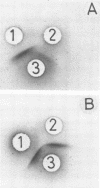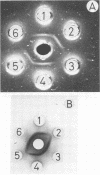Abstract
Two fragments with molecular weights of 111,000 (fragment I) and 59,000 (fragment II) were separated from each other by gel filtration of dithiothreitol and urea-treated, trypsinized derivative toxin (molecular weight, 170,000) of the proteolytic Okra strain of Clostridium botulinum type B on a column of Sephadex G-200 (superfine) with a buffer containing dithiothreitol and urea. Upon removal of dithiothreitol and urea by dialysis, the two fragments reassembled to reconstruct the derivative toxin molecule. Both fragments were immunogenic, and both anti-fragments neutralized type B toxin. The neutralizing activities of both anti-fragment I and anti-fragment II were, however, lower than that of the anti-derivative toxin, suggesting that the molecular integrity of derivative toxin is essential for sufficient production of the neutralizing antibody. The immunological difference found between type B toxin from a proteolytic strain and that from a nonproteolytic strain was ascribed to the antigenic difference of fragment I.
Full text
PDF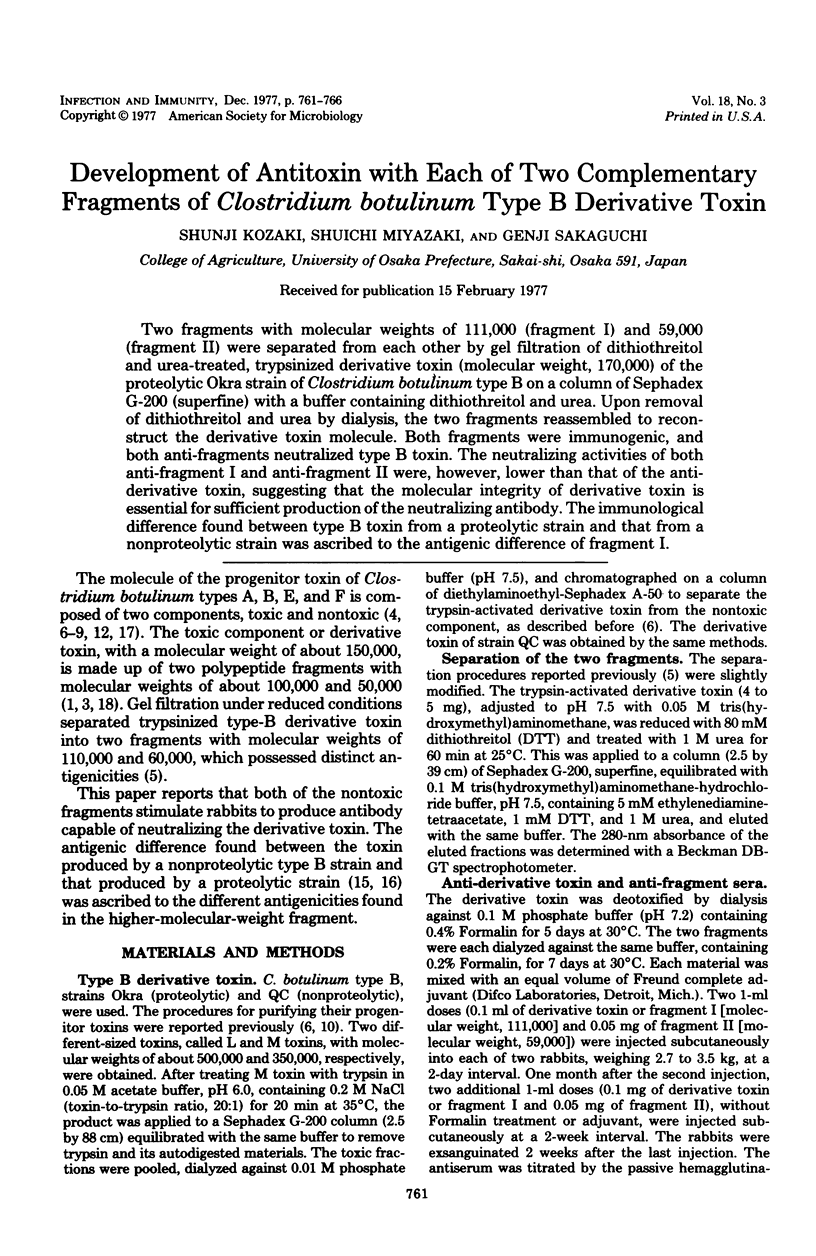
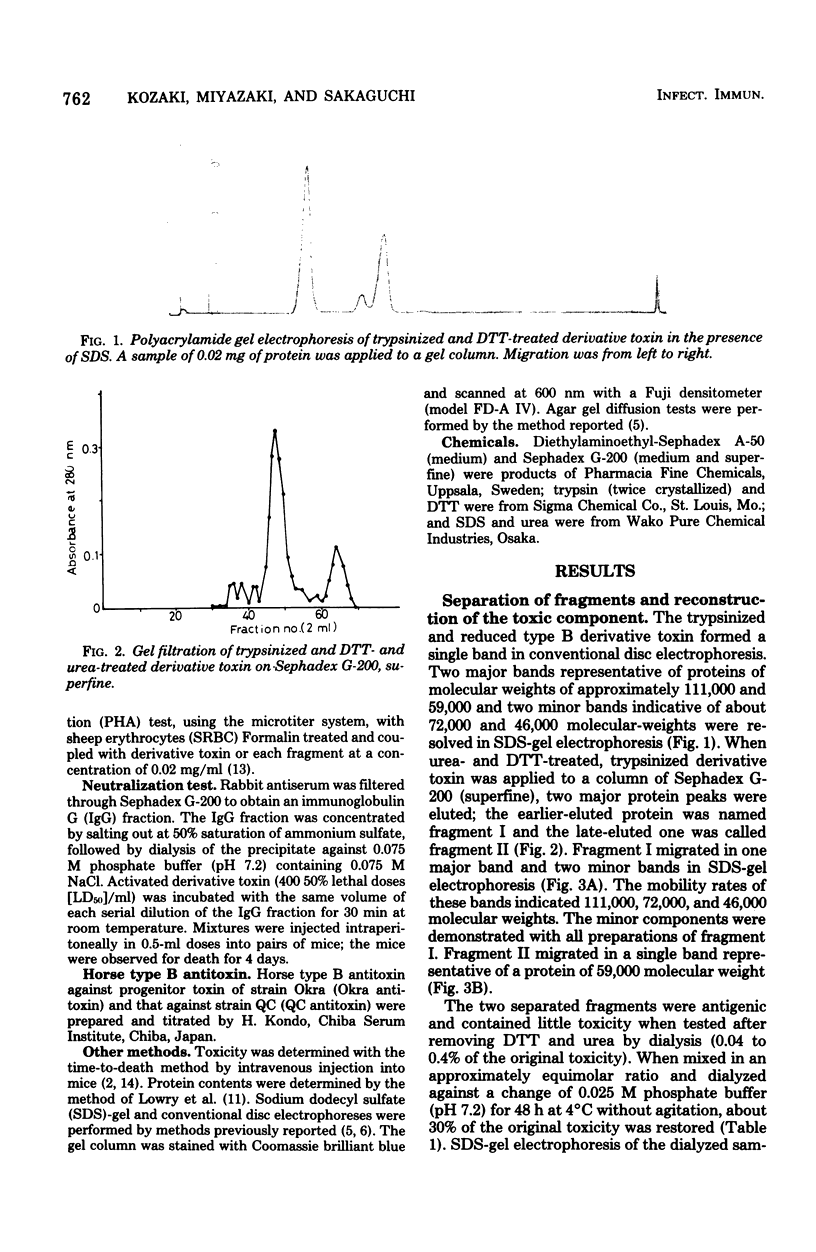
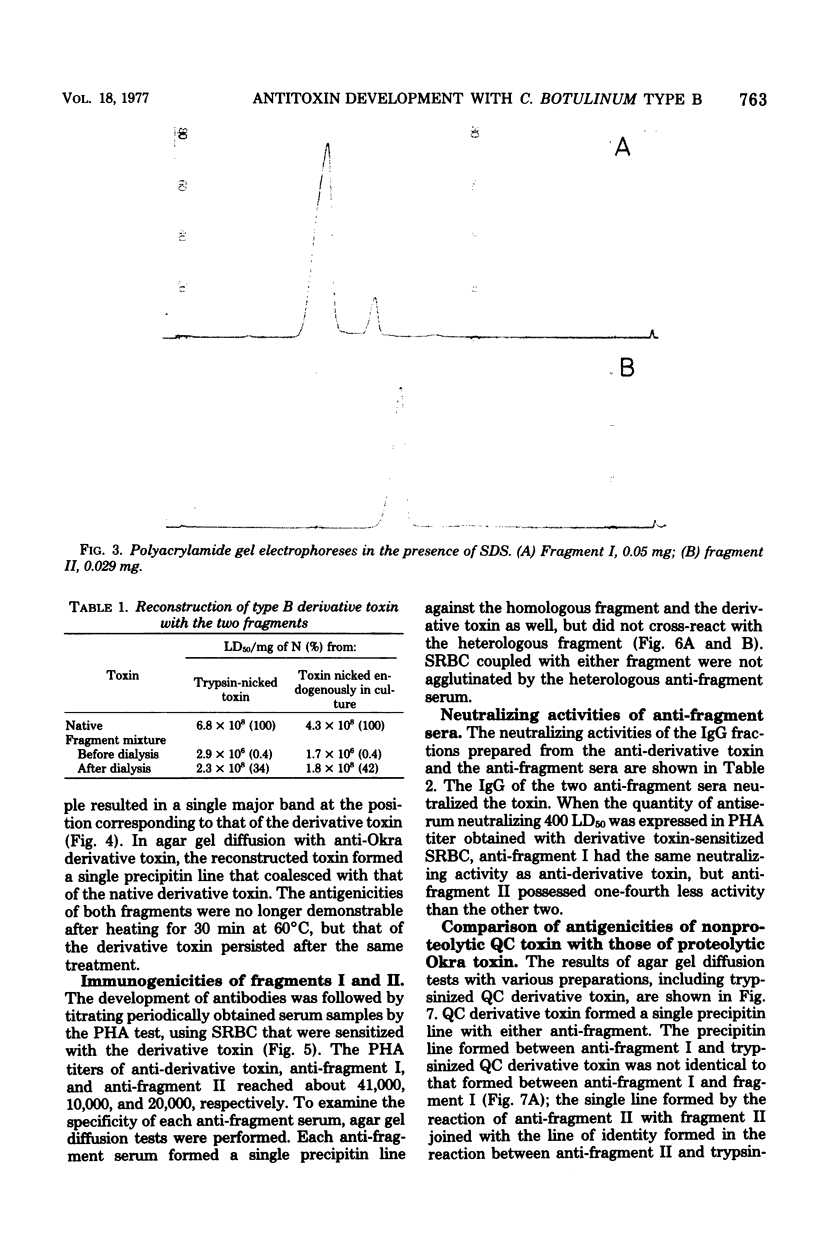
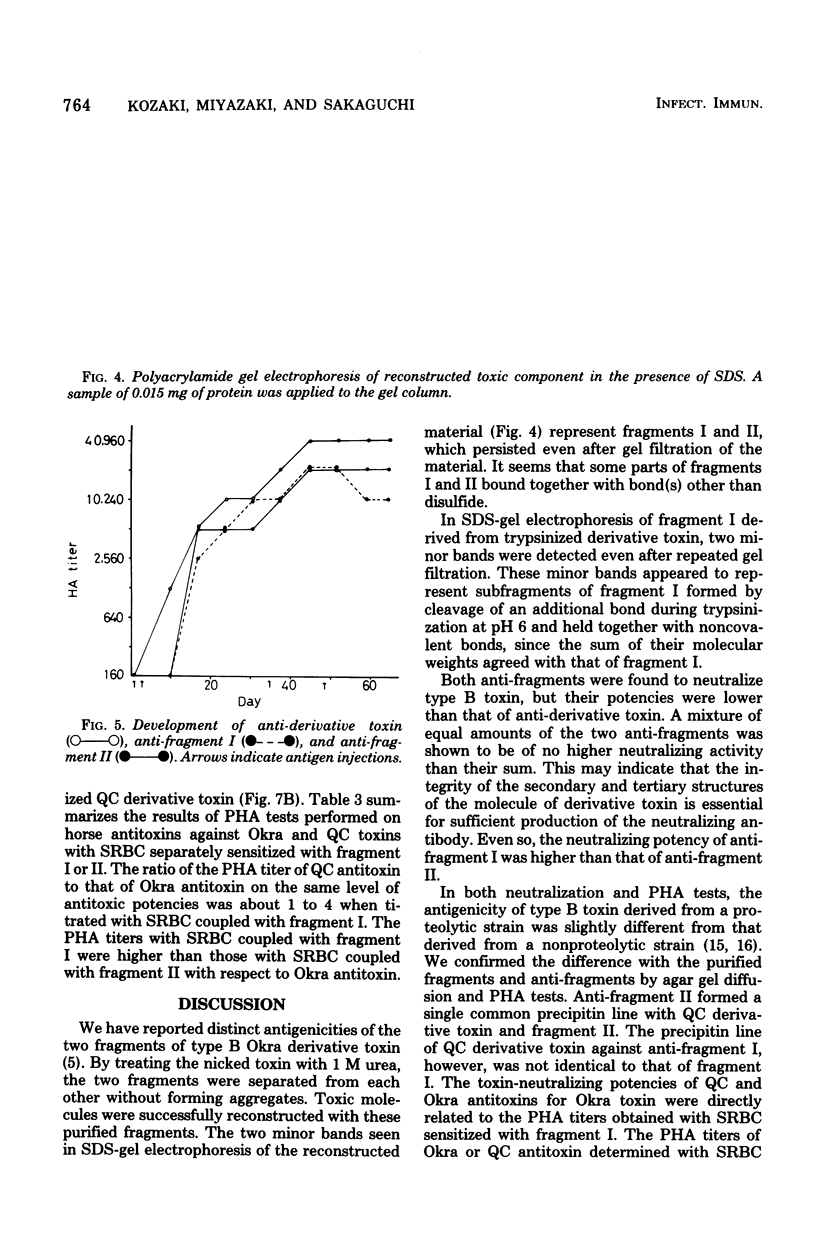
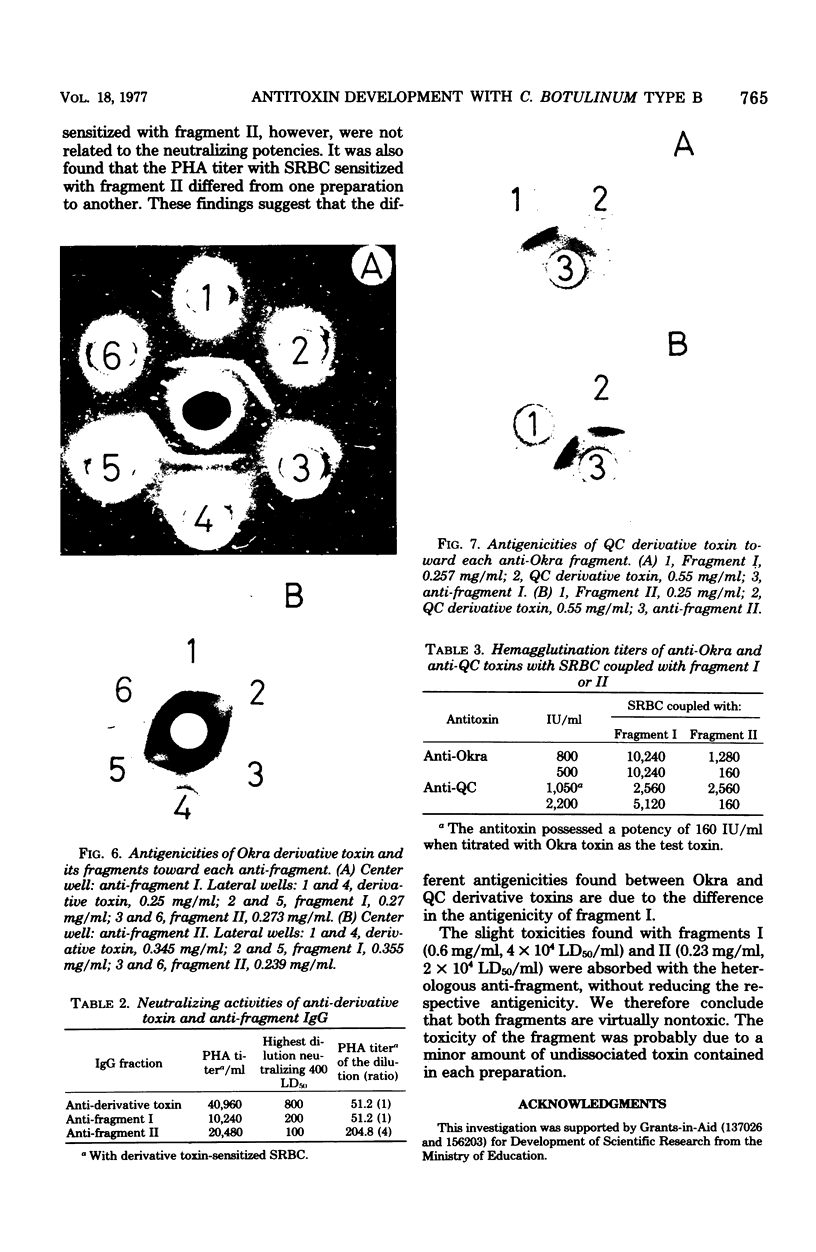
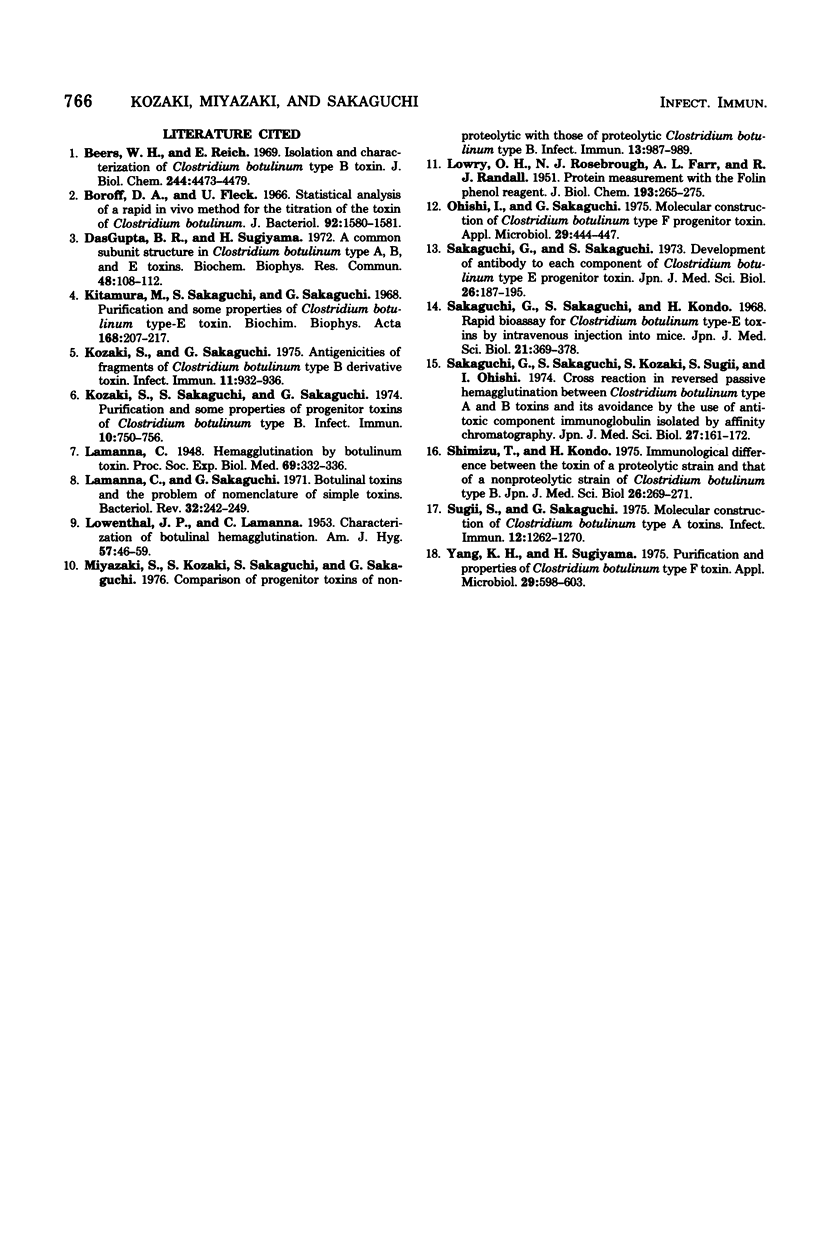
Images in this article
Selected References
These references are in PubMed. This may not be the complete list of references from this article.
- Beers W. H., Reich E. Isolation and characterization of Clostridium botulinum type B toxin. J Biol Chem. 1969 Aug 25;244(16):4473–4479. [PubMed] [Google Scholar]
- Boroff D. A., Fleck U. Statistical analysis of a rapid in vivo method for the titration of the toxin of Clostridium botulinum. J Bacteriol. 1966 Nov;92(5):1580–1581. doi: 10.1128/jb.92.5.1580-1581.1966. [DOI] [PMC free article] [PubMed] [Google Scholar]
- DasGupta B. R., Sugiyama H. A common subunit structure in Clostridium botulinum type A, B and E toxins. Biochem Biophys Res Commun. 1972 Jul 11;48(1):108–112. doi: 10.1016/0006-291x(72)90350-6. [DOI] [PubMed] [Google Scholar]
- Kitamura M., Sakaguchi S., Sakaguchi G. Purification and some properties of Clostridium botulinum type-E toxin. Biochim Biophys Acta. 1968 Oct 21;168(2):207–217. doi: 10.1016/0005-2795(68)90144-x. [DOI] [PubMed] [Google Scholar]
- Kozaki S., Sakaguchi G. Antigenicites of fragments of Clostridium botulinum type B derivative toxin. Infect Immun. 1975 May;11(5):932–936. doi: 10.1128/iai.11.5.932-936.1975. [DOI] [PMC free article] [PubMed] [Google Scholar]
- Kozaki S., Sakaguchi S., Sakaguchi G. Purification and some properties of progenitor toxins of Clostridium botulinum type B. Infect Immun. 1974 Oct;10(4):750–756. doi: 10.1128/iai.10.4.750-756.1974. [DOI] [PMC free article] [PubMed] [Google Scholar]
- LOWENTHAL J. P., LAMANNA C. Characterization of botulinal hemagglutination. Am J Hyg. 1953 Jan;57(1):46–59. doi: 10.1093/oxfordjournals.aje.a119562. [DOI] [PubMed] [Google Scholar]
- LOWRY O. H., ROSEBROUGH N. J., FARR A. L., RANDALL R. J. Protein measurement with the Folin phenol reagent. J Biol Chem. 1951 Nov;193(1):265–275. [PubMed] [Google Scholar]
- Lamanna C., Sakaguchi G. Botulinal toxins and the problem of nomenclature of simple toxins. Bacteriol Rev. 1971 Sep;35(3):242–249. doi: 10.1128/br.35.3.242-249.1971. [DOI] [PMC free article] [PubMed] [Google Scholar]
- Miyazaki S., Kozaki S., Sakaguchi S., Sakaguchi G. Comparison of progenitor toxins of nonproteolytic with those of proteolytic Clostridium botulinum Type B. Infect Immun. 1976 Mar;13(3):987–989. doi: 10.1128/iai.13.3.987-989.1976. [DOI] [PMC free article] [PubMed] [Google Scholar]
- Ohishi I., Sakaguchi G. Molecular construction of Clostridium botulinum type F progenitor toxin. Appl Microbiol. 1975 Apr;29(4):444–447. doi: 10.1128/am.29.4.444-447.1975. [DOI] [PMC free article] [PubMed] [Google Scholar]
- Sakaguchi G., Sakaguchi S. Development of antibody to each component of Clostridium botulinum type E progenitor toxin. Jpn J Med Sci Biol. 1973 Dec;26(5):187–195. doi: 10.7883/yoken1952.26.187. [DOI] [PubMed] [Google Scholar]
- Sakaguchi G., Sakaguchi S., Kondo H. Rapid bioassay for Clostridium botulinum type-E toxins by intravenous injection into mice. Jpn J Med Sci Biol. 1968 Dec;21(6):369–378. doi: 10.7883/yoken1952.21.369. [DOI] [PubMed] [Google Scholar]
- Sakaguchi G., Sakaguchi S., Kozaki S., Sugii S., Oishi I. Cross reaction in reversed passive hemagglutination between Clostridium botulinum type A and B toxins and its avoidance by the sue of anti-toxic component immunoglobulin isolated by affinity chromatography. Jpn J Med Sci Biol. 1974 Jun;27(3):161–172. doi: 10.7883/yoken1952.27.161. [DOI] [PubMed] [Google Scholar]
- Shimizu T., Kondo H. Immunological difference between the toxin of a progeolytic strain and that of a nonproteolytic strain of Clostridium botulinum type B. Jpn J Med Sci Biol. 1973 Dec;26(5):269–271. doi: 10.7883/yoken1952.26.269. [DOI] [PubMed] [Google Scholar]
- Sugii S., Sakaguchi G. Molecular construction of Clostridium botulinum type A toxins. Infect Immun. 1975 Dec;12(6):1262–1270. doi: 10.1128/iai.12.6.1262-1270.1975. [DOI] [PMC free article] [PubMed] [Google Scholar]
- Yang K. H., Sugiyama H. Purification and properties of Clostridium botulinum type F toxin. Appl Microbiol. 1975 May;29(5):598–603. doi: 10.1128/am.29.5.598-603.1975. [DOI] [PMC free article] [PubMed] [Google Scholar]






